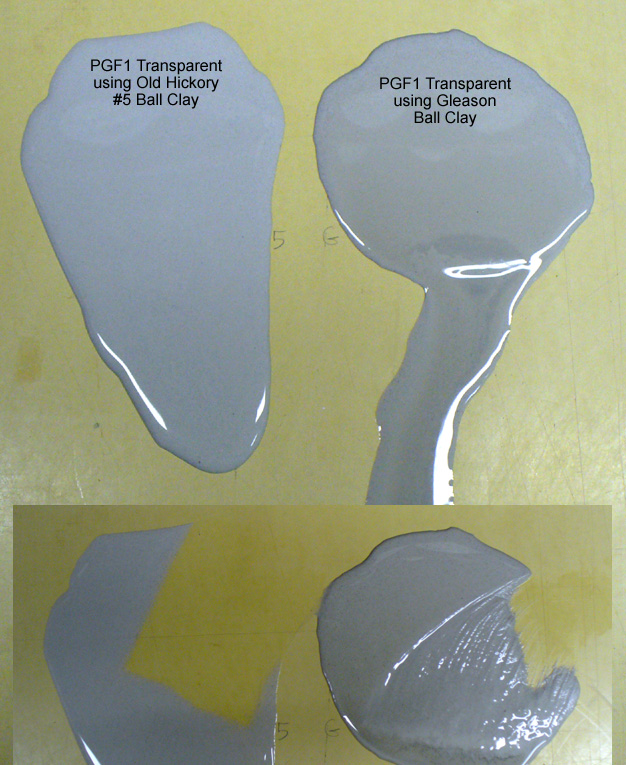| Monthly Tech-Tip | No tracking! No ads! | |
No. 5 Ball Clay
Alternate Names: OH #5, OH#5, Old Hickory #5 Ball Clay
Description: White burning Kentucky ball clay, low carbon for plastic bodies
| Oxide | Analysis | Formula | Tolerance |
|---|---|---|---|
| CaO | 0.06% | - | |
| K2O | 0.80% | 0.03 | |
| MgO | 0.18% | 0.02 | |
| Na2O | 0.09% | 0.01 | |
| TiO2 | 1.26% | 0.06 | |
| Al2O3 | 28.40% | 1.00 | |
| SiO2 | 58.80% | 3.51 | |
| Fe2O3 | 0.79% | 0.02 | |
| LOI | 9.30% | n/a | |
| Oxide Weight | 324.60 | ||
| Formula Weight | 357.89 | ||
Notes
A popular secondary clay used to add plasticity to clay bodies and aid in glaze suspension. This ball clay is the base for a number of very popular premixed plastic porcelain and whiteware bodies in the USA. It is fires to a light grey color with about 13% shrinkage at cone 10. Many potters claim that this is the whitest firing ball clay available in North America. In the powder form, it looks much more like a light beige kaolin than a grey ball clay. This ball clay works very well as a glaze suspender and hardener in amounts of around 15-20% (if too much more is used it gels the slurry). Of course, other common ball clays work also, just not as well.
The manufacturer calls it a unique grade that is virtually carbon-free and contains a high amount of kaolinite (Al2O3) content. It has excellent fired brightness along with good plasticity. It can be employed at typical ball clay percentages in bodies. The plasticity and strength values of this can be improved by the addition of some sodium bentonite in small percentages.
Crude Color: White
Dry M.O.R. (psi 50% clay/50% flint, cast bars): 305
Wet Sieve Residue, +200 mesh (%): 0.22
Water of Plasticity (%): 33
Linear Dry Shrinkage (%): 6.5
Solubles Sulfates (ppm): 115
Filtration (ml): 26
Specific Surface Area (sq meters per gram): 18.9
CEC/MBI (meq/100 ml): 9.5
pH: 6.0
PCE: 32
Firing Shrinkage (%)
Cone 04: 4.5
Cone 3: 6.6
Cone 11: 7.5
Absorption (%)
Cone 04: 15.8
Cone 3: 12.7
Cone 11: 5.0
Particle Size (% finer than):
50 microns: 99
20: 98
10: 94
5: 86
1: 62
0.5: 52
Median Particle Diameter (micron): 0.46
Related Information
The ball clay you use to suspend your glaze is important!

This picture has its own page with more detail, click here to see it.
I poured 4 teaspoons of two glazes onto a non-absorbent butcher’s board and let them sit for a minute, then inclined the board. The one on the right employs Gleason Ball clay, the left one has Old Hickory #5 ball clay. Neither has any rheology modifier additions. The one on the right has settled and, on incline of the board, the watery upper is running off. The other has gelled and the whole thing is running downward slowly. Below that you can see where I have begun to sponge them off, the one on the right is sticky. The most amazing thing about this: This difference appears despite the fact that there is only 7% ball clay in this heavily fritted recipe.
Links
| Materials |
Spinks HC#5 Clay
|
| Materials |
No. 1 Glaze Ball Clay
|
| Materials |
Ball Clay
A fine particled highly plastic secondary clay used mainly to impart plasticity to clay and porcelain bodies and to suspend glaze, slips and engobe slurries. |
| Typecodes |
Ball Clay
Ball clays are abundant and very plastic and are used in all types of plastic forming bodies. They are not as white-burning or refractory as kaolins but lower in iron and fluxes than bentonites. |
| By Tony Hansen Follow me on        |  |
Got a Question?
Buy me a coffee and we can talk

https://digitalfire.com, All Rights Reserved
Privacy Policy
